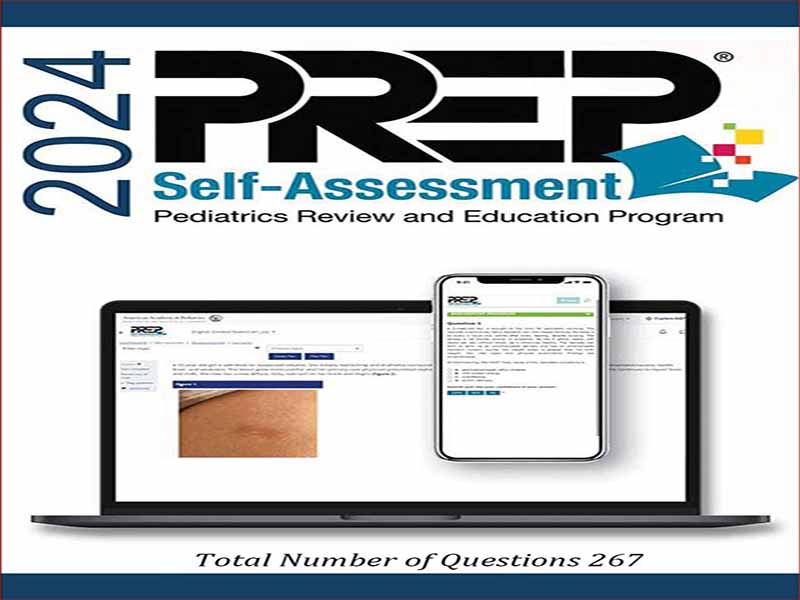- عنوان: AAP PREP 2024
- نویسنده: PREP
- حوزه: پزشکی اطفال
- سال انتشار: 2024
- تعداد صفحه: 736
- زبان اصلی: انگلیسی
- نوع فایل: pdf
- حجم فایل: 15.5 مگابایت
AAP PREP 2024 – سوال 1/267 – سوال آلرژی 1/1
یک کودک 8 ساله قبل از انجام تست حساسیت پوستی تحت بررسی است. آنها سابقه آسم پایدار متوسط، درماتیت آتوپیک خفیف و رینیت آلرژیک شدید دارند. دو هفته پیش توسط متخصص اطفال از نظر سرفه و خس خس سینه معاینه شدند و یک دوره 5 روزه استروئید خوراکی تجویز شد. داروهای آنها شامل کورتیکواستروئیدهای استنشاقی روزانه، یک استروئید داخل بینی روزانه، یک آنتی هیستامین خوراکی قبل از خواب و یک بتا آگونیست استنشاقی کوتاه اثر در صورت نیاز است. این کودک روزانه از نرم کننده ها برای پوست خشک خود استفاده می کند و در مواردی از کرم استروئیدی موضعی کم قدرت استفاده می کند، آخرین مورد 2 ماه پیش. از موارد زیر، عاملی که بیشترین احتمال تداخل را با آزمایشات تشخیصی این کودک دارد، استفاده از کورتیکواستروئید استنشاقی B. D. مصرف اخیر کورتیکواستروئید خوراکی است.
پاسخ صحیح C است
PREP Pearl(های)
آزمایش آلرژی فقط باید همراه با شرح حال کامل و معاینه فیزیکی انجام شود. تست پوستی و تستهای IgE اختصاصی سرم واکنشهای حساسیت مفرط فوری به آلرژنهای خاص را شناسایی میکنند که ممکن است اجتناب انتخابی و ایمونوتراپی را تسهیل کند. آنتی هیستامین های خوراکی و موضعی با تست خراش پوستی تداخل دارند و استفاده از آنها باید قبل از انجام آزمایش قطع شود.
انتقاد
از میان گزینههای پاسخ، استفاده از آنتی هیستامین خوراکی به احتمال زیاد با تست پوستی (SPT) تداخل دارد. تست Skinprick توسط متخصصین آلرژی آموزش دیده در مطب انجام می شود تا پاسخ IgE به آلرژن های خاص را تشخیص دهد. آزمایش شامل سوراخ کردن پوست و وارد کردن آلرژن های خاص به لایه اپیدرمی است. چرخه و اریتم حاصل اندازه گیری می شود. هیستامین به عنوان کنترل مثبت و سالین به عنوان کنترل منفی استفاده می شود. از آنجایی که هیستامین یک واسطه مهم در پاسخ به شعله ور و شعله ور است، استفاده از آنتی هیستامین بر تفسیر SPT تأثیر می گذارد. دوره های کوتاه کورتیکواستروئیدهای خوراکی و استروئیدهای استنشاقی یا داخل بینی روزانه تأثیری بر نتایج SPT ندارد. اگرچه استفاده از استروئیدهای موضعی قوی ممکن است نتایج SPT را تحت تأثیر قرار دهد، کودک در تصویر فقط از استروئیدهای موضعی کم قدرت استفاده کرد و آخرین استفاده آنها 2 ماه پیش بود. درماتیت آتوپیک تنها در صورتی منع مصرف برای SPT است که محل و شدت التهاب پوست با تفسیر آزمایش تداخل داشته باشد. کودک در وینیت دارای درماتیت آتوپیک خفیف است که نباید با SPT تداخل داشته باشد. قرار گرفتن در معرض آلرژن ها با مشاهده پاسخ بالینی بعدی در یک محیط کنترل شده استاندارد مرجع برای آزمایش تشخیصی آلرژی است (به عنوان مثال، چالش غذای خوراکی، تحریک اندام های آلرژی زا). با این حال، گاهی اوقات این آزمایشات ممکن است عملی یا مناسب نباشند (به دلیل نگرانی های ایمنی بیمار). Skinprick و تست IgE اختصاصی سرم برای شناسایی محرکهای غذایی و محیطی خاص با واکنشهای حساسیت مفرط فوری IgEmediated استفاده میشود. نتایج راهنمای اجتناب انتخابی و ایمونوتراپی (برای موارد مقاوم به درمان). این تست ها در شناسایی واکنش های تاخیری با واسطه سلول های T مفید نیستند.
AAP PREP 2024 – Question 1/267 – Allergy Question 1/1
An 8-year-old is being evaluated before undergoing skin-prick allergy testing. They have a history of moderate persistent asthma, mild atopic dermatitis, and severe allergic rhinitis. Two weeks ago, they were evaluated by their pediatrician for a cough and wheezing and a 5-day course of oral steroids was prescribed. Their medications include daily inhaled corticosteroids, a daily intranasal steroid, an oral antihistamine at bedtime, and a short-acting β-agonist inhaler as needed. The child uses emollients for her dry skin daily and a low-potency topical steroid cream on occasion, most recently 2 months ago. Of the following, the factor MOST likely to interfere with this child’s diagnostic testing is their B. inhaled corticosteroid use D. recent oral corticosteroid use
Correct answer is C
PREP Pearl(s)
Allergy testing should be obtained only in conjunction with a thorough history and physical examination. Skin-prick testing and serum-specific IgE tests identify immediate hypersensitivity reactions to specific allergens, which may facilitate selective avoidance and immunotherapy. Oral and topical antihistamines interfere with skin-prick testing, and their use must be discontinued before testing.
Critique
Of the response choices, oral antihistamine use is most likely to interfere with skin-prick testing (SPT). Skinprick testing is performed by trained allergists in the office setting to detect an IgE response to specific allergens. Testing involves puncturing the skin and introducing specific allergens into the epidermal layer. The resulting wheal and erythema are measured. Histamine is used as a positive control and saline as a negative control. Because histamine is an important wheal and flare response mediator, antihistamine use affects the interpretation of SPT. Short courses of oral corticosteroids and daily inhaled or intranasal steroids do not affect SPT results. Although use of potent topical steroids may affect SPT results, the child in the vignette used only low-potency topical steroids, and their last use was 2 months ago. Atopic dermatitis is a contraindication for SPT only if the location and severity of skin inflammation interfere with interpretation of the test. The childin the vignette has mild atopic dermatitis, which should not interfere with SPT. Exposure to allergens with subsequent observation of the clinical response in a controlled setting is the reference standard for diagnostic allergy testing (eg, oral food challenge, aeroallergen organ provocation). However, at times these tests may not be practical or appropriate (owing to patient safety concerns). Skinprick and serum-specific IgE testing are used to identify specific food and environmental triggers with IgEmediated immediate hypersensitivity reactions. The results guide selective avoidance and immunotherapy (for refractory cases). These tests are not useful in identifying T-cell mediated delayed reactions.
این کتاب را میتوانید بصورت رایگان از لینک زیر دانلود نمایید.
Download: AAP PREP 2024




































نظرات کاربران